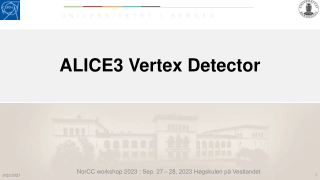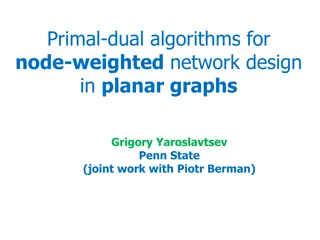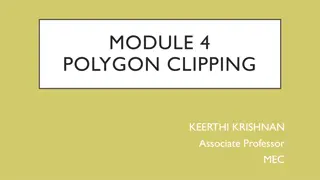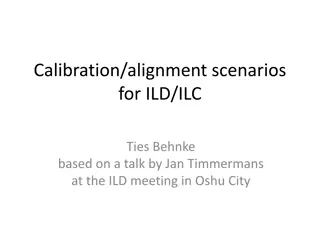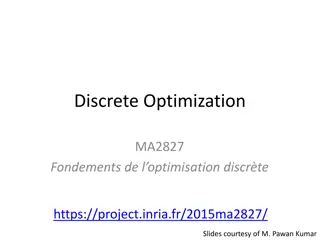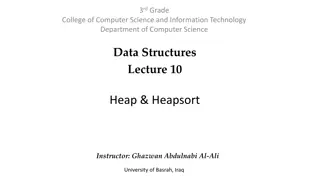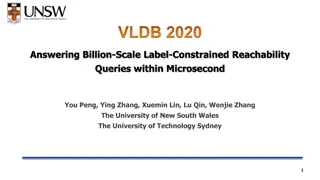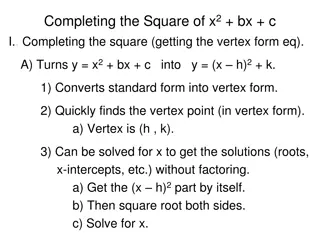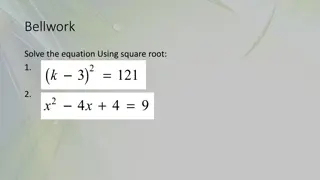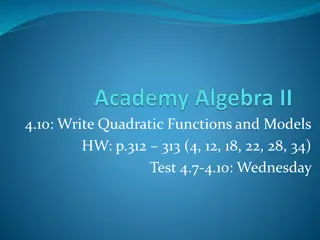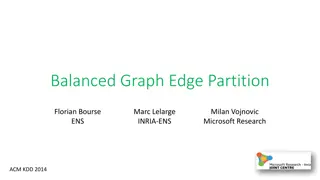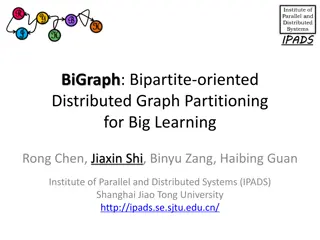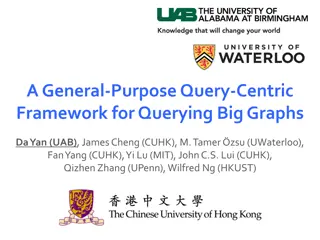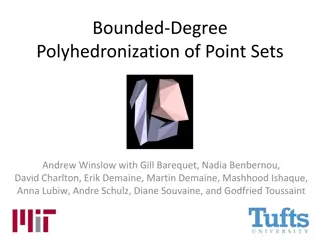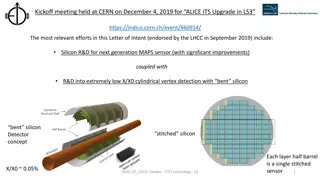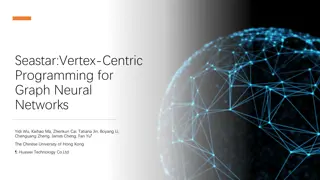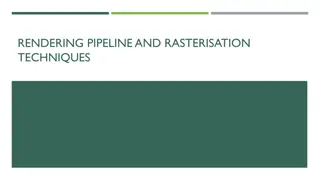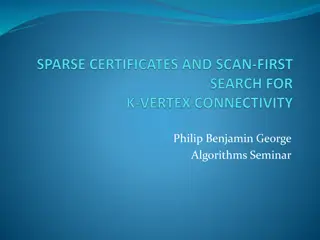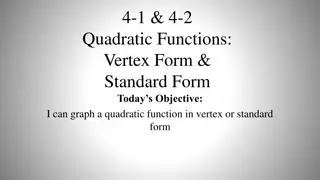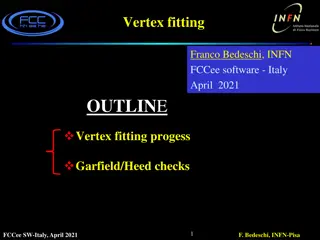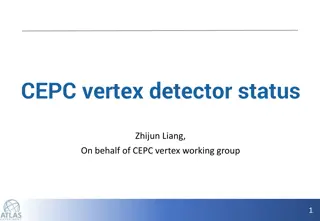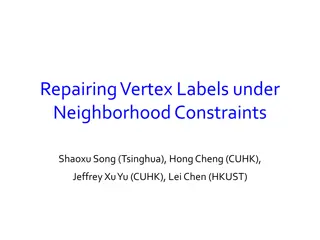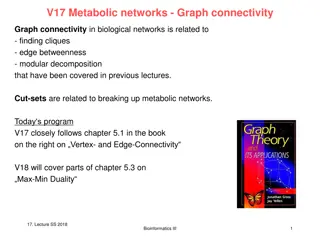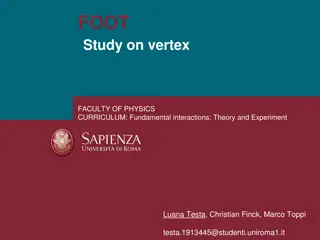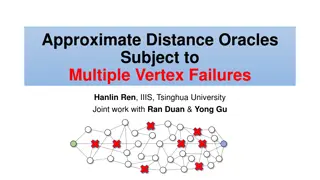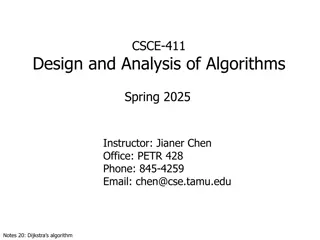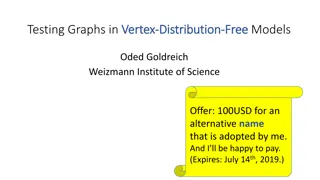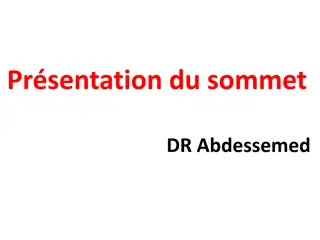ALICE3 Vertex Detector
ALICE3 Vertex Detector NorCC workshop in 2023 to learn about the key objectives and role of the ALICE Experiment's Inner Tracking System (ITS) in particle tracking and identification.
1 views • 19 slides
Primal-Dual Algorithms for Node-Weighted Network Design in Planar Graphs
This research explores primal-dual algorithms for node-weighted network design in planar graphs, focusing on feedback vertex set problems, flavors and toppings of FVS, FVS in general graphs, and FVS in planar graphs. The study delves into NP-hard problems, approximation algorithms, and previous rela
2 views • 17 slides
Polygon Clipping Techniques and Algorithms
Polygon clipping involves modifying line-clipping procedures to achieve bounded areas after clipping. The Sutherland-Hodgman algorithm is commonly used, where polygon boundaries are processed against window edges to generate closed areas for appropriate area fill. This process involves testing for v
2 views • 17 slides
Mastering Quadratic Functions: Graphing Through Transformations
Explore the vertex form of quadratic equations, understand transformation rules, and learn step-by-step methods for graphing quadratics with examples and practice problems. Enhance your skills in identifying vertices, plotting points, and visualizing the U-shaped graphs of quadratic functions.
0 views • 10 slides
Alignment Scenarios for ILD/ILC Ties Behnke
The calibration and alignment scenarios for ILD/ILC presented at the meeting in Oshu City focus on the initial requirements for tracking, alignment precision, track-based alignment, track samples, vertex detector alignment, and Si tracker alignment techniques. The detailed specifications include lig
3 views • 9 slides
Discrete Optimization: Fundamentals and Applications
Explore the foundations of discrete optimization in MA2827 with a focus on graph theory, complexity basics, shortest path algorithms, minimum spanning trees, maximum flow, and more. Dive into concepts such as Menger's Theorem, disjoint paths, path packing, and directed graphs. Gain insights into ver
0 views • 34 slides
Data Structures and Heaps in Computer Science - Lecture 10 Overview
Explore the concept of heaps and heapsort in data structures, focusing on the binary heap data structure as an array object that resembles a nearly complete binary tree. Learn about binary tree representations, heap properties, and vertex assignments in a linear array to enhance search efficiency. U
1 views • 33 slides
Efficient Billion-Scale Label-Constrained Reachability Queries
Graph data sets are prevalent in various domains like social networks and biological networks. Label-Constrained Reachability (LCR) queries aim to determine if a vertex can reach another vertex through specific labeled edges. Existing works utilize exhaustive search or graph indexing techniques, but
0 views • 13 slides
Completing the Square Method: Vertex Form and Solving Equations
The Completing the Square method helps convert quadratic equations from standard form to vertex form, facilitating the quick determination of the vertex point and the solutions without factoring. By completing the square, you transform equations like y = x^2 + bx + c into y = (x − h)^2 + k, enabli
0 views • 5 slides
Algebraic Equations and Quadratic Functions Exploration
Explore the world of algebraic equations and quadratic functions through visual aids and interactive activities. Learn to solve equations using square roots, complete the square, write functions in vertex form, and work with algebra tiles to visualize mathematical concepts. Discover the relationship
0 views • 22 slides
Quadratic Functions and Models: Characteristics and Equations
Explore writing quadratic functions given specific characteristics such as vertices, x-intercepts, and points passed through. Learn how to form equations in vertex form, intercept form, and standard form by plugging in values and solving systems of equations. Practice creating quadratic functions wi
1 views • 8 slides
Balanced Graph Edge Partition and Its Practical Applications
Balanced graph edge partitioning is a crucial problem in graph computation, machine learning, and graph databases. It involves partitioning a graph's vertices or edges into balanced components while minimizing cut costs. This process is essential for various real-world applications such as iterative
4 views • 17 slides
Massively Parallel Algorithm for Minimum Weight Vertex Cover
Massively Parallel Computation (MPC) model for solving the Minimum Weight Vertex Cover problem efficiently, including optimal round complexities and known approximation ratios. The algorithm is designed for graphs with vertices and edges, with each machine processing data synchronously in rounds. Va
0 views • 13 slides
BiGraph: Bipartite-Oriented Distributed Graph Partitioning for Big Learning
BiGraph is a distributed graph partitioning algorithm designed for bipartite graphs, offering a scalable solution for big data processing in Machine Learning and Data Mining applications. The algorithm addresses the limitations of existing partitioning methods by efficiently distributing and managin
0 views • 45 slides
Query-Centric Framework for Big Graph Querying
A comprehensive exploration of Google's Pregel system, outlining its design, programming interfaces, vertex partitioning, vertex states, and practical examples like Breadth-First Search. The framework provides insights into large-scale graph processing by thinking like a vertex and leveraging messag
0 views • 30 slides
Bounded Degree Polyhedronization of Point Sets in R3
The problem of finding a polyhedron in R3 with no four points coplanar, having the set of points as vertices, being simple in structure, with each vertex connected to O(1) edges, and featuring both a tetrahedralization and chain dual. This task has historical importance with Euler's formula setting
0 views • 24 slides
Update on ALICE ITS Upgrade Efforts at CERN
Kickoff meeting for the ALICE ITS Upgrade in LS3 was held at CERN on December 4, 2019. The efforts focus on silicon R&D for next-gen MAPS sensor with improvements, low X/X0 cylindrical vertex detection, and a new sensor design. Milestones, organization of efforts, and future plans towards an EIC sil
0 views • 6 slides
Vertex-Centric Programming for Graph Neural Networks
Seastar presents a vertex-centric programming approach for Graph Neural Networks, showcasing better performance in graph analytic tasks compared to traditional methods. The research introduces the SEAStar computation pattern and discusses GNN programming abstractions, execution, and limitations. Dee
0 views • 17 slides
Rendering Pipeline and Rasterisation Techniques in Graphics APIs
Explore the rendering pipeline in OpenGL and DirectX, learn optimization techniques for rasterization, compare common modules in the pipeline, and delve into fundamental optimization methods post-vertex processing. Dive into literature resources and system models, and understand the OpenGL rendering
1 views • 26 slides
K-Vertex Connected Graphs and Connectivity Algorithms
Delve into the world of K-vertex connected graphs and algorithms that focus on connectivity. Understand the concept of k-connectivity certificates, sparse certificates, and the efficient Scan-First Search algorithm for constructing connectivity certificates in parallel. Witness the application of th
0 views • 17 slides
Lock-Free Multi-Threaded Algorithm for Max-Flow Problem
This paper discusses a lock-free multi-threaded algorithm for addressing the Max-Flow Problem efficiently, presenting existing algorithms, vertex properties, impact of locking, and a new lock-free algorithm model. The content covers various sequential and parallel algorithms, vertex characteristics,
1 views • 17 slides
Graph Exploration Concepts and Algorithms
In this presentation, various graph exploration strategies and terminologies are discussed, including BFS running time, BFS properties, DFS for directed graphs, DFS edge classification, and detailed DFS examples. The content delves into the characteristics and processes involved in breadth-first sea
0 views • 23 slides
Characteristics of Sampling Methods in Social Networks
Demystify sampling methods in social networks through various techniques like random walks, uniform vertex sampling, and edge sampling. Explore how these methods help in evaluating network structures accurately and efficiently across different platforms. Understand the pros and cons of uniform edge
0 views • 26 slides
Detecting Feedback Vertex Sets in Graphs
Feedback Vertex Sets (FVS) play a crucial role in solving deadlock recovery in operating systems. This research explores the efficient detection of FVS of various sizes in undirected graphs, impacting deadlock resolution and system performance. The study delves into algorithms and techniques for ide
0 views • 21 slides
Color Specification in WebGL: Vertex and Fragment Shaders
Colors in WebGL are specified for each vertex and fragment using shaders. By passing specific colors for each vertex using color data arrays, we can control the color rendering process. This involves setting colors at the vertex level and passing them to the shaders for fragment processing.
0 views • 24 slides
Graphing Quadratic Functions: Vertex and Standard Forms
Today's objective is to graph quadratic functions in vertex or standard form. Learn about the vertex form, standard form, transformations, and how to plot parabolas with given equations. Understand how to find the vertex, axis of symmetry, and other key attributes of quadratic functions.
0 views • 11 slides
Vertex Fitting Progress and Performance Analysis in FCCee Software
In this April 2021 report from Italy, Franco Bedeschi of INFN outlines the progress in vertex fitting using the Garfield/Heed checks. Performance examples with specific event details are provided, showcasing the capabilities of the FCCee software. The report also details the way forward, including p
0 views • 7 slides
Possible R&D Lines for FCC-ee Vertex and Detector Requirements
In preparation for the FCC-France contact meeting, this session will cover state-of-the-art developments in the field, focusing on the requirements for the Vertex Detector. Discussions will include studies on hit rates, integration times, power dissipation, and architecture simulation. Additionally,
0 views • 8 slides
CEPC vertex detector status
CEPC Vertex Detector Working Group discussing key parameters, technology choices, timeline, and collaboration updates. Review the latest meeting minutes and plans for the future development of the detector.
0 views • 5 slides
Repairing Vertex Labels under Neighborhood Constraints
Repairing Vertex Labels under Neighborhood Constraints is a study focusing on addressing inconsistencies in data by enforcing constraints on vertex labels within a network. The approach combines a simple greedy heuristic with a contraction-based technique to enhance data accuracy and integrity, lead
0 views • 14 slides
Graph Connectivity in Biological Networks: Exploring Vertex and Edge Connectivity
Understanding graph connectivity in biological networks is crucial for analyzing vulnerability and survivability. Explore concepts like vertex and edge connectivity, cut-sets, and network decomposition in V17 Metabolic Networks lecture series.
1 views • 40 slides
Impressive Discoveries in ORCA Vertex Fitting Analysis
Explore groundbreaking findings on aashowerfit and vertex fitting in the ORCA nue-cc file, shedding light on potential improvements and future directions for research in the field.
0 views • 4 slides
Study on Vertex Reconstruction Algorithm and Validity Classifications
Explore the study on vertex reconstruction algorithm and validity classifications in the field of fundamental interactions, comparing results with previous campaigns and highlighting the significance of assessing algorithm performance through distribution acquisition. The research delves into vertex
0 views • 19 slides
Advanced Vertex Tracking Detector Simulation and Performance Study
Explore the simulation and performance study of the advanced EicC vertex tracking detector, including new tracker designs, material budget analysis, tracking efficiency assessment, and study of hit requirements. Dive into cutting-edge research in particle physics instrumentation.
0 views • 7 slides
Achieving Elasticity in Distributed Graph Processing
Explore techniques like Contiguous Vertex Repartitioning and Ring-based Vertex Repartitioning to support on-demand elasticity in distributed graph processing systems. Learn how to migrate vertices effectively and when to initiate migration during computation.
0 views • 35 slides
Approximate Distance Oracles for Handling Multiple Vertex Failures in Networks
Explore the challenges of dealing with failures in networks through the lens of approximate distance oracles, with a focus on scenarios involving multiple vertex failures. Discover solutions and approaches to efficiently address this complex problem.
0 views • 21 slides
Single-Source Shortest Path Problem and Dijkstra's Algorithm
Explore the Single-Source Shortest Path Problem in both directed and undirected graphs, along with an in-depth look at Dijkstra's Algorithm for finding the shortest path between two vertices. Understand the concept of growing a tree rooted at a starting vertex and the process of adding the best-look
0 views • 12 slides
Testing Graphs in Vertex Distribution-Free Models by Oded Goldreich
Explore the world of property testing in graphs with vertex distribution-free models proposed by Oded Goldreich from Weizmann Institute of Science. Learn about sublinear-time approximate decision and practical scenarios to make testing more realistic.
0 views • 11 slides
Presentation of Fetal Vertex - Diagnostic, Clinical Stages, and Delivery Process
Learn about the presentation of the fetal vertex, including diagnostic methods, clinical stages during childbirth, and the process of delivery. Explore engagement, descent-rotation, and final delivery stages of occipito-pubic emergence in both anterior and posterior variations.
0 views • 17 slides
Discrete Relaxation Techniques for Solving NP-hard Problems
Exploring the concept of Fixed Parameter Tractability (FPT) algorithms through discrete relaxation methods, this presentation discusses how problems such as Vertex Cover, Multiway Cut, and others can be solved efficiently by utilizing techniques like half-integrality, LP-branching, and more. The tal
0 views • 27 slides
